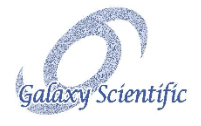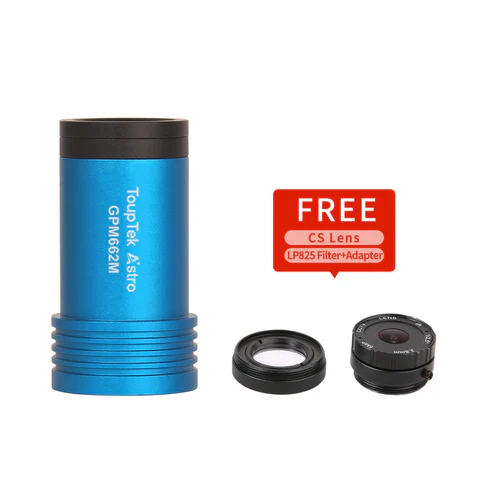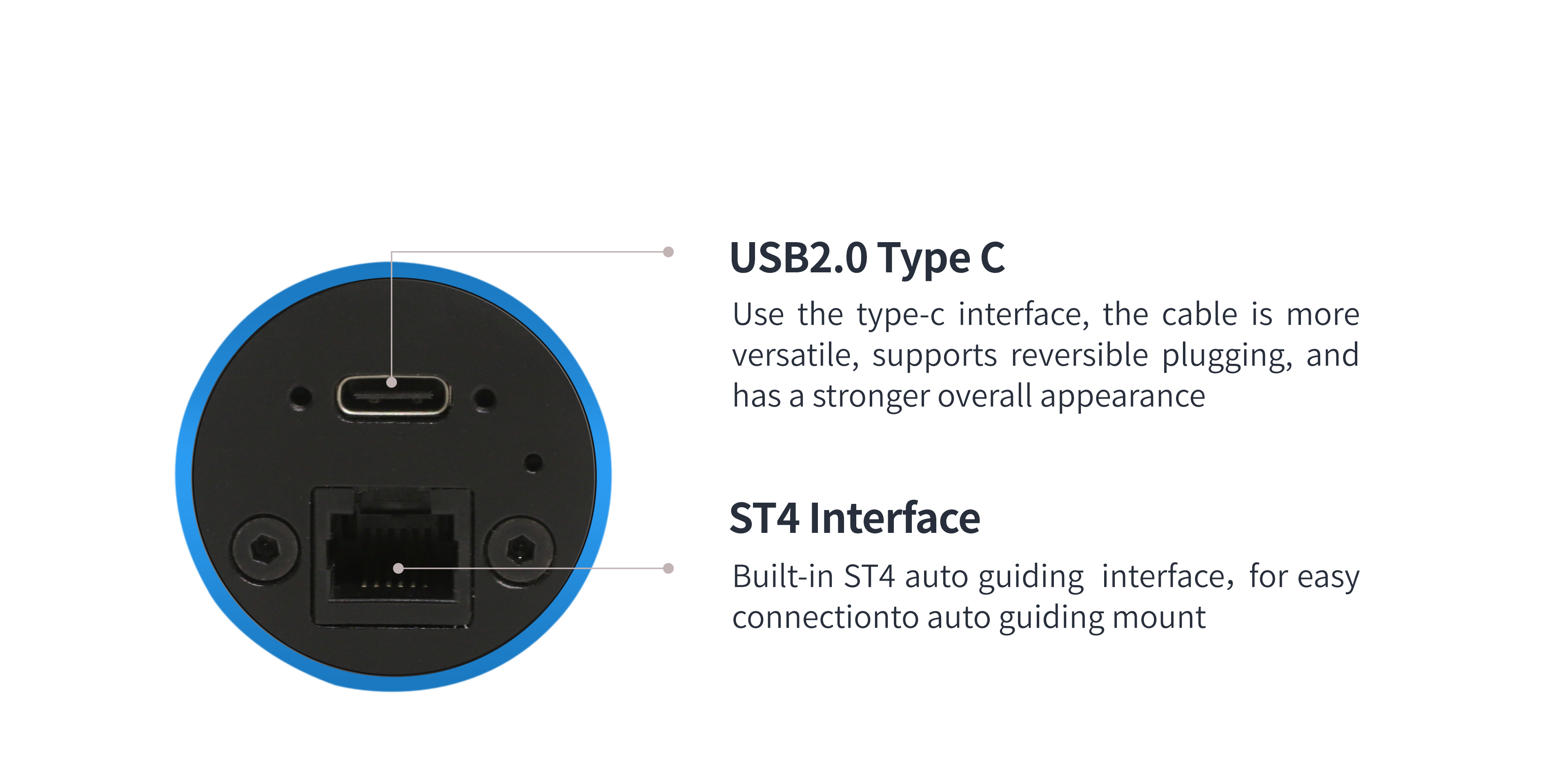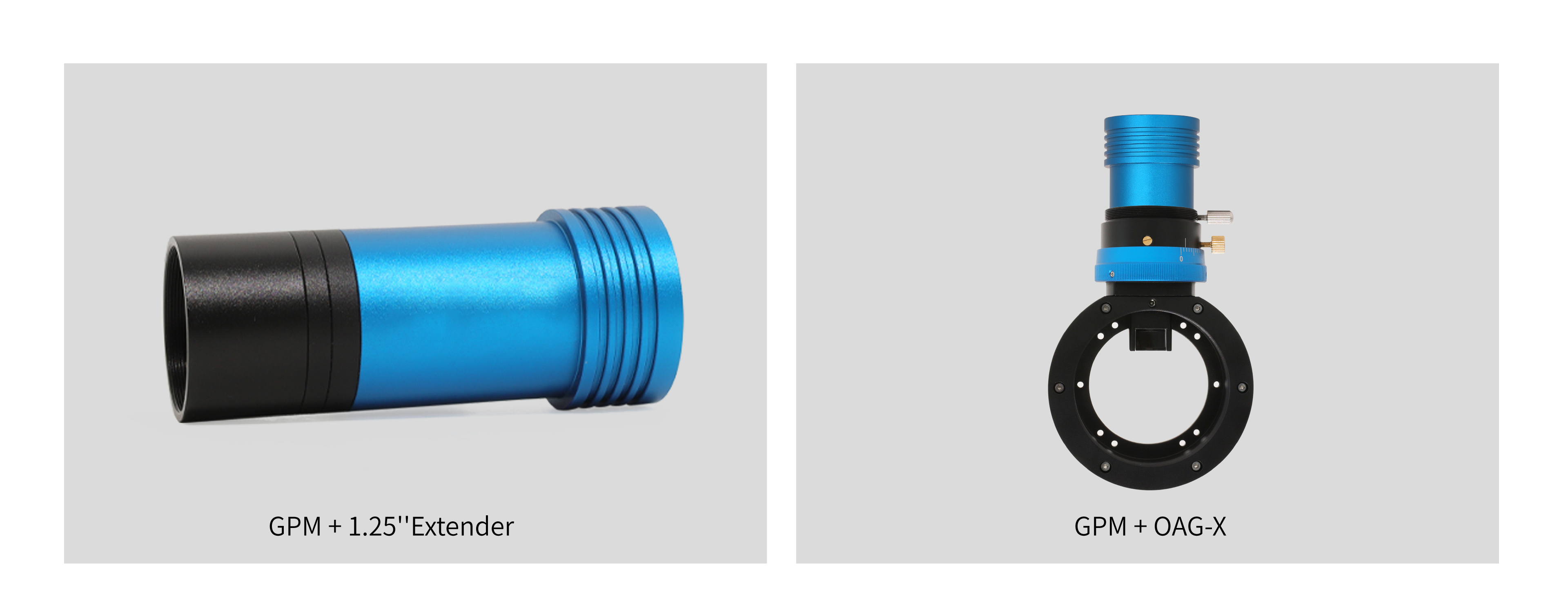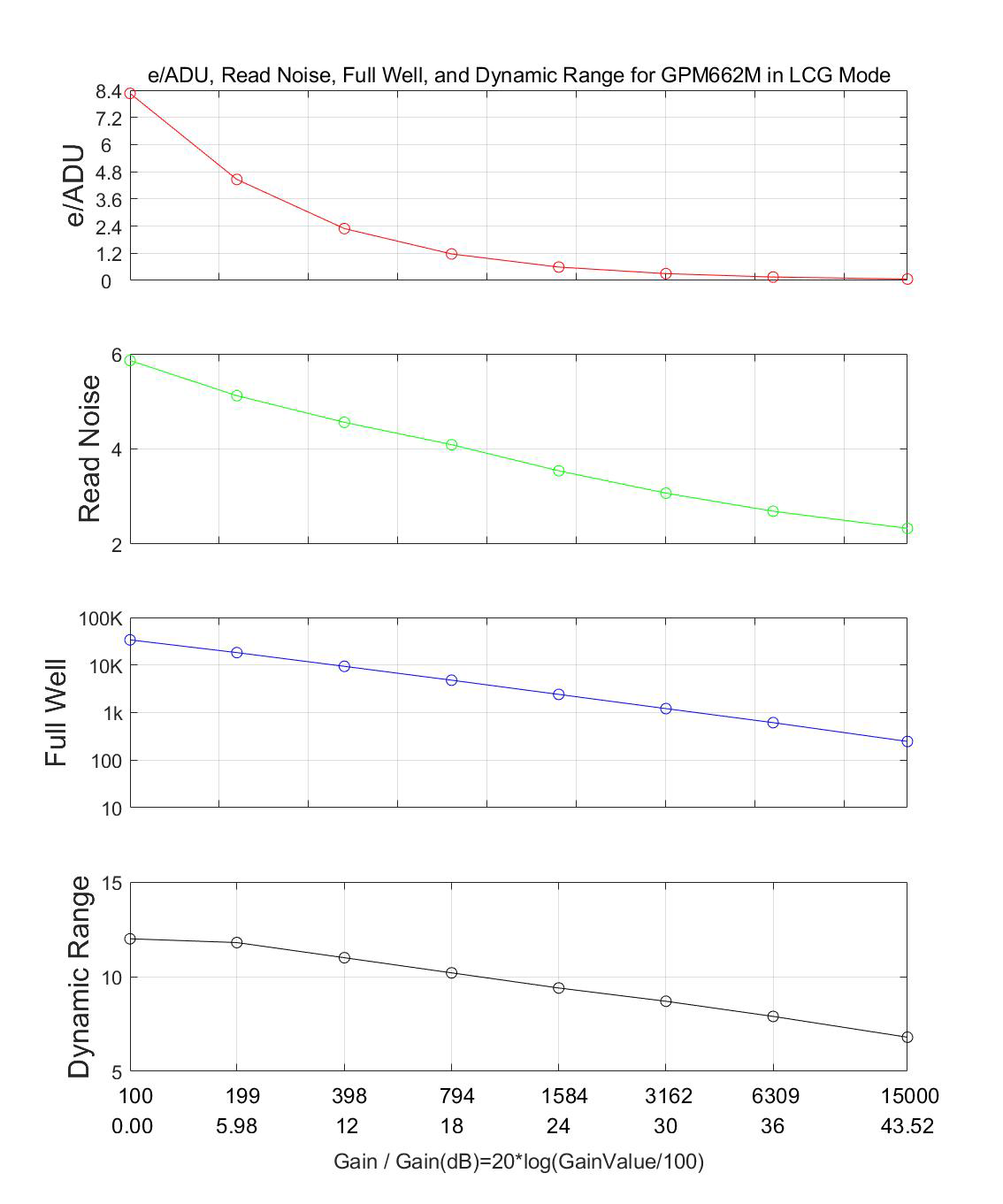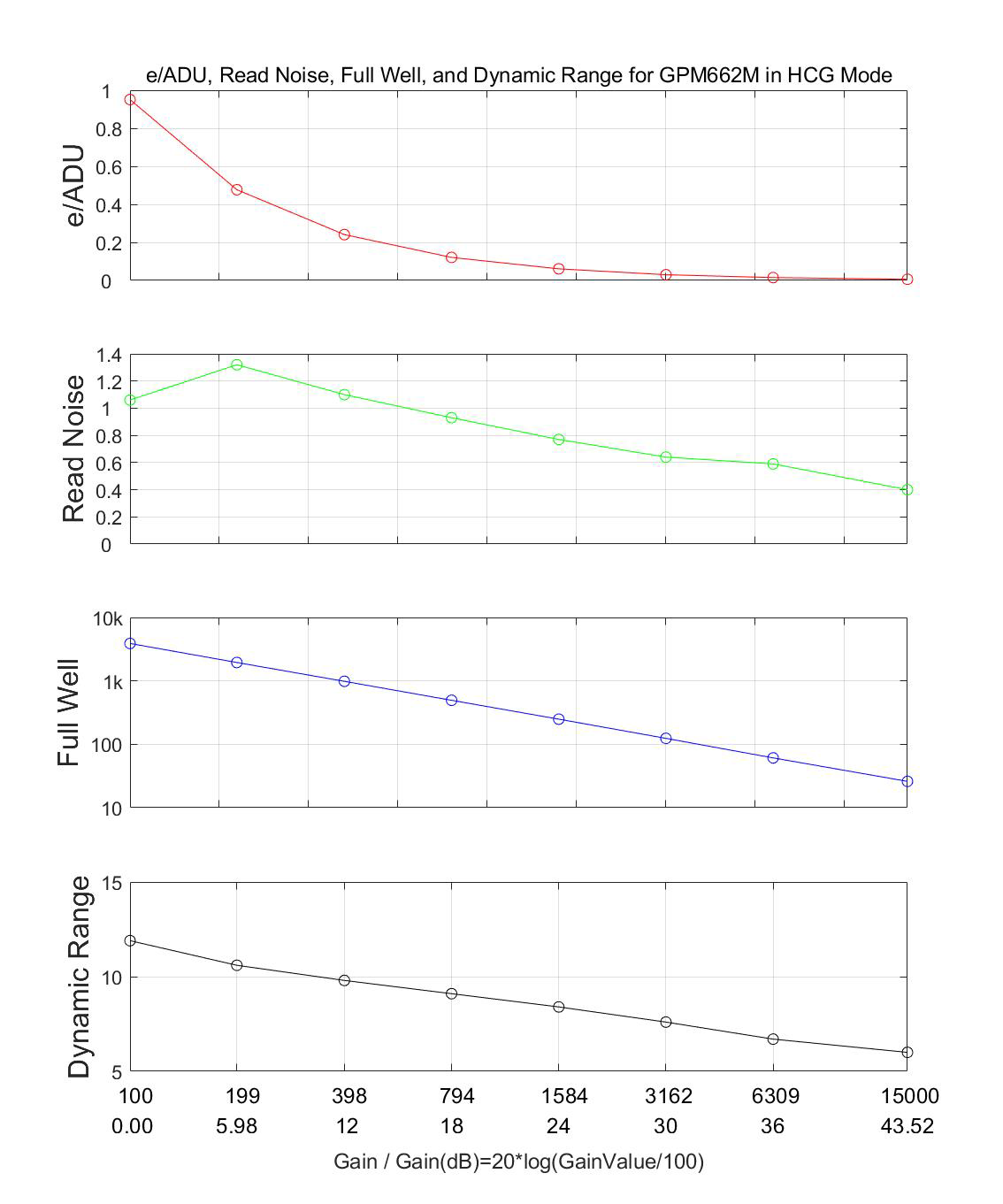A professional monochrome guide camera featuring Sony's latest IMX662 back-illuminated CMOS sensor, offering exceptionally strong infrared light capture capability, large full well capacity, high dynamic range, high sensitivity, and ultra-low readout noise for outstanding performance in planetary, solar, and lunar photography.

Function Description
The GPM662M camera possesses an exceptionally strong capability to capture infrared light with high QE values at 650nm. It features a large full well capacity, high dynamic range, high sensitivity, and low readout noise among other advantages. Equipped with HCG/LCG dual gain mode switching, the minimum read noise can reach 0.4e⁻, making it one of the lowest read noise monochrome guide cameras currently available. This results in outstanding performance in planetary photography, as well as in solar and lunar photography.
GPM662M Key Features:
- IMX662 Mono CMOS Sensor
- Resolution: 2.1 Megapixels (1920×1080)
- 2.9 micron square pixels
- 1/2.8-inch optical format
- 12-bit ADC
- Built-in frame buffer
- HCG/LCG dual gain modes
- G Sensitivity: 8970 mv, 1/30s
- Noise: 0.4 to 5.86e⁻
- Up to 18 FPS at 8-bit mode
- Maximum SNR: 45.3 dB
- Dynamic Range: 75.2 dB
- Built-in ST4 autoguider interface
- Peak Quantum Efficiency: >91%
Core Features
0.4 e⁻
Ultra-Low Read Noise
Industry-leading low noise performance
33.8 ke⁻
Large Full Well Capacity
Exceptional dynamic range performance
> 91%
Peak Quantum Efficiency
Extremely high photoelectric conversion
75.2 dB
Dynamic Range
Capture more light and shadow details
HCG/LCG
Dual Gain Modes
Flexible adaptation to different scenarios
ST4
Guide Interface
Direct connection to mount for precise guiding
Technical Advantages
Sony IMX662 Monochrome Sensor Technology
The GPM662M features Sony's latest IMX662 monochrome sensor with exceptional infrared sensitivity. With read noise as low as 0.4e⁻, full well capacity of 33.8ke⁻, and dynamic range reaching 75.2dB, the GPM662M delivers outstanding performance for demanding astronomical applications. The monochrome sensor provides superior quantum efficiency and eliminates the Bayer pattern interpolation, resulting in sharper images with better detail resolution.
Sony IMX662 Spectral Sensitivity
The GPM662M sensor has a G sensitivity of 8970mv at 1/30s. Its spectral response range covers 380-1100nm (with AR protect window), delivering exceptional sensitivity across the entire visible spectrum and into the near-infrared range. The monochrome sensor's extended infrared response makes it particularly effective for capturing emission nebulae and other deep-sky objects that emit strongly in the red and near-infrared wavelengths.
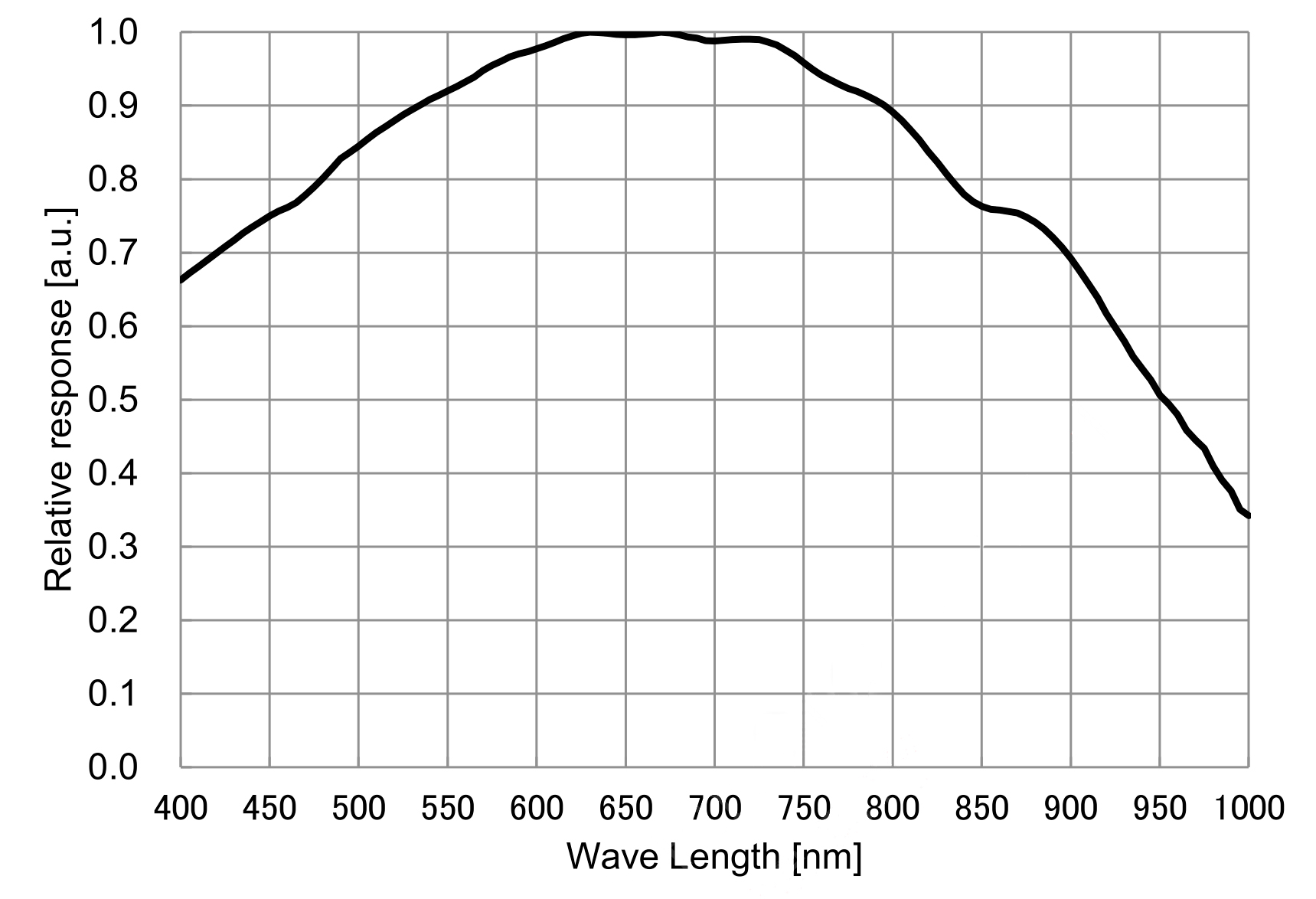
HCG/LCG Dual Gain Modes
The GPM662M supports switching between HCG (High Conversion Gain) and LCG (Low Conversion Gain) modes, providing optimized performance for different imaging scenarios:
HCG High Conversion Gain Mode
- Ultra-Low Read Noise: As low as 0.4e⁻
- Application Scenarios: Faint star guiding, deep sky object guiding
- Full Well Capacity: 3.89ke⁻
- Advantages: Provides best signal-to-noise ratio in low light conditions
LCG Low Conversion Gain Mode
- Large Full Well Capacity: 33.8ke⁻
- Application Scenarios: Bright star guiding, planetary and solar imaging
- Read Noise: 5.86e⁻
- Advantages: Extremely wide dynamic range, prevents overexposure
Smart Frame Buffer Technology
Understanding Frame Buffer Technology
Frame buffer is a dedicated high-speed memory component integrated directly into the camera hardware. Think of it as an intelligent data staging area that temporarily stores captured image frames before they are transmitted to your computer via USB.
How Frame Buffer Works:
When the camera sensor captures an image, the data is first written to the frame buffer memory at extremely high speeds. From there, it's transmitted to your computer at the rate supported by your USB connection. This two-stage process provides several critical advantages:
Key Benefits of Frame Buffer:
- Prevents Data Loss:If your USB connection experiences temporary slowdowns or your computer is busy processing other tasks, the frame buffer continues collecting sensor data without interruption. This prevents dropped frames and ensures no precious imaging data is lost during critical capture moments.
- Reduces Amp Glow:By efficiently managing data transfer, the frame buffer minimizes the time electronics remain active near the sensor, effectively reducing amplifier glow (amp-glow) that can appear as unwanted brightness in image corners during long exposures.
- Enables Consistent Frame Rates:The buffer smooths out variations in USB transfer speeds, maintaining steady frame rates even when system resources fluctuate. This is especially important for precise autoguiding where timing consistency is critical.
- Multi-Camera Operation:When running multiple cameras simultaneously (such as main imaging camera plus guide camera), each camera's frame buffer operates independently. This ensures maximum performance from each camera without data bottlenecks or interference between devices.
- Backward Compatibility:Frame buffer technology allows the GPM662M to work reliably even with older USB 2.0 connections or lower-specification computers, making it an excellent choice for field setups where cutting-edge computing power may not be available.
In practical terms: The frame buffer acts like a shock absorber for your data stream, ensuring smooth, reliable image capture regardless of momentary system hiccups or resource constraints. This technology is particularly valuable during long imaging sessions where data integrity and consistency are paramount.
12-bit ADC and Intelligent ROI
The GPM662M features native 12-bit ADC, providing 4096 gray levels for capturing subtle tonal gradations. The camera supports hardware ROI (Region of Interest) functionality - smaller ROI sizes achieve higher frame rates, which is particularly useful in guiding applications where only a small area containing the guide star needs high-speed acquisition.
Frame Rates at Different Resolutions/Bit Depths/Data Transfer Interfaces
Unit: Frames per second (FPS) - USB 2.0 interface
Flexible Pixel Binning
The GPM662M supports digital pixel binning from 1×1 to 8×8 in either stacking or averaging method. Pixel binning technology can improve signal-to-noise ratio, particularly useful in faint guiding conditions by combining adjacent pixels to enhance guide star signals while reducing read noise impact.
Built-in ST4 Autoguider Interface
The GPM662M features a built-in standard ST4 guide interface for easy connection to the autoguider. This design simplifies guiding system configuration, reduces cable connections, and improves system reliability. Compatible with mainstream guiding software like PHD Guiding, MetaGuide, Nebulosity, MaxIm DL, and others for precise autoguiding control.
Comprehensive Connection Options
The GPM series cameras offer versatile connection options designed for seamless integration with various telescope setups and guiding systems. The diagram below illustrates the complete connection architecture, showing how the camera interfaces with your mount, computer, and other astronomical equipment for optimal guiding performance.
Connection Features:
- USB 2.0 Type-C interface for both data transfer and power supply
- ST4 autoguider port for direct mount connection
- Compatible with all major guiding software platforms
- No external power supply required - powered entirely through USB
Broad Software Compatibility
The GPM662M supports multiple driver interfaces including Native, ASCOM, and WDM, compatible with mainstream astronomy software such as PHD Guiding, Nebulosity, MaxIm DL, SharpCap, MetaGuide, FireCapture, and AstroArt. Provides multi-platform SDK support for Windows, Linux, macOS, including development interfaces for Native C/C++, C#/VB.NET, Python, Java, DirectShow, and Twain.
Convenient Power System
The camera operates via USB 2.0 interface. Upon establishing a connection with the host system using the USB 2.0 cable, the device is primed for operation. This design is particularly suitable for field observations, reducing power cable complexity.
Technical Specifications
Core Performance Parameters
| Maximum Frame Rate (USB 2.0) |
12-bit: 8.9 FPS @ 1920×1080
8-bit: 17.8 FPS @ 1920×1080 |
| Read Noise |
HCG: 0.4-1.06e⁻ | LCG: 2.33-5.86e⁻ |
| Full Well Capacity |
HCG: 3.89ke⁻ | LCG: 33.8ke⁻ |
| Peak Quantum Efficiency |
>91% |
| Dynamic Range |
75.2 dB |
| Signal-to-Noise Ratio |
45.3 dB |
| Exposure Time Range |
0.1ms - 1000s |
| Gain Range |
1× - 150× |
Basic Technical Specifications
| Sensor |
Sony IMX662 Monochrome Back-illuminated CMOS |
| Image Resolution |
2.1 Megapixels (1920×1080) |
| Pixel Size |
2.9μm × 2.9μm |
| Sensor Size |
1/2.8-inch (diagonal 6.45mm) |
| Imaging Area |
5.57mm × 3.13mm |
| Shutter Type |
Rolling Shutter |
| ADC Bit Depth |
12-bit |
| Frame Buffer |
Built-in |
| Gain Modes |
HCG/LCG dual mode switching |
| Spectral Response Range |
380-1100nm (with AR protect window) |
Interface and Physical Specifications
| Data Interface |
USB 2.0 Type-C |
| Guide Interface |
Built-in ST4 autoguider port |
| Camera Adapter |
Standard 1.25-inch for telescope connection
Standard CS adapter for industrial lens |
| Back Focal Distance |
8.5mm (17.5mm with C-mount, 12.5mm with CS-mount) |
| Protective Window |
IR-cut filter/AR-window |
| External Dimensions |
Diameter 37mm × Height 72.4mm |
| Weight |
65.3 grams |
| Cooling Method |
Passive cooling |
| Supported Systems |
Windows XP/Vista/7/8/10/11 (32 & 64 bit)
Mac OS X, Linux |
| SDK Support |
Native C/C++, C#/VB.NET, Python
Java, DirectShow, Twain, etc. |
Camera Interface & Dimensions
Interface Description
- Directly connects with 1.25-inch telescope eyepiece holders
- GPM with 1.25-inch extension tube can be inserted directly into 1.25-inch telescope eyepiece holders
- Standard CS adapter connects to industrial CS-mount adapter lenses
- Built-in ST4 autoguider port for easy connection to the autoguider
- USB 2.0 Type-C interface provides data transfer and power supply
- CS adapter ring consists of a double-layer adapter ring - removing top ring allows connection of 1.25-inch filters
Package Contents
Standard Configuration Includes:
AGPM662M Monochrome Guide Camera Main Unit (with Type-CS-Mount inner) × 1
BUSB 2.0 Data Cable (2 meters, Type-A to Type-C) × 1
CST4 Guide Cable (2 meters) × 1
D1.25-inch Nosepiece × 1
E5mm Adapter Ring × 1
Gift box dimensions: Length 19.5cm × Width 16cm × Height 6cm (each package weighs approximately 0.8-1.0 kilograms)
Carton dimensions: Length 50cm × Width 30cm × Height 30cm (20 pieces, 12-17kg per carton, 0.045m³)
